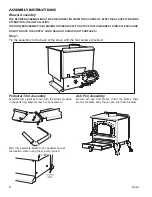
12|13
X. OVERNIGHT BURNING
When leaving the stove in use overnight, the fire door must be closed. Close all air flow dials and
dampen the fire down by covering it with a coating of coal dust or dross.
IMPORTANT
•
Do not fully load the appliance until you are familiar with the operation of all stove controls.
•
Do not open the loading door too quickly when reloading the appliance. This can cause flames to
flash out of the stove similarly to a ‘mini-explosion’.
•
Do not burn painted or varnished woods, MDF, oak barn or wood with more than 20% humidity.
XI. AIR CONTROLS
It is essential that the fire has an adequate air supply for combustion and ventilation. The apertures
provided for this purpose must not be restricted.
Leaving the vents fully open for long periods, however, can cause over-firing. For overnight burning, the air
vents should be closed.
The airwash vent is located at the top of the stove door. This controls the burning rate and keeps the glass
clean. When fully open, this gives full airwash for faster burning and clean glass. Fully closed gives slow,
overnight burning. A fully closed airwash control will not keep the glass clean, especially immediately
after refuelling.
XII. ASH CLEARANCE AND DISPOSAL
The appliance must have ash removed from the ashpan on a regular basis. Ash should be removed from
the fire chamber and ashpan using a suitable tool such as a brush or ash vacuum. Never allow ash to
accumulate so that it comes into contact with the underside of the grate as this can cause damage.
It is important that all air vents are clear of ash and there is no ash build up on baffles or firebricks. This
needs to be done as and when necessary to maintain free movement of air inside the stove.
The efficient operation of your stove is dependant on correct operation and maintenance. Failure to
carry out the removal of ash will significantly reduce output.
Ensure ash is cool before emptying into plastic liners or dustbins.
CAUTION:
Each stove has a kilowatt rating. This is the approximate maximum temperature the casting
is able to cope with. It does not relate to heat production which depends on the type and quantity of fuel
used. If you require less heat, burn a smaller fire. If the stove becomes white or red hot, spray the fire
down with water from a plant spray.


































